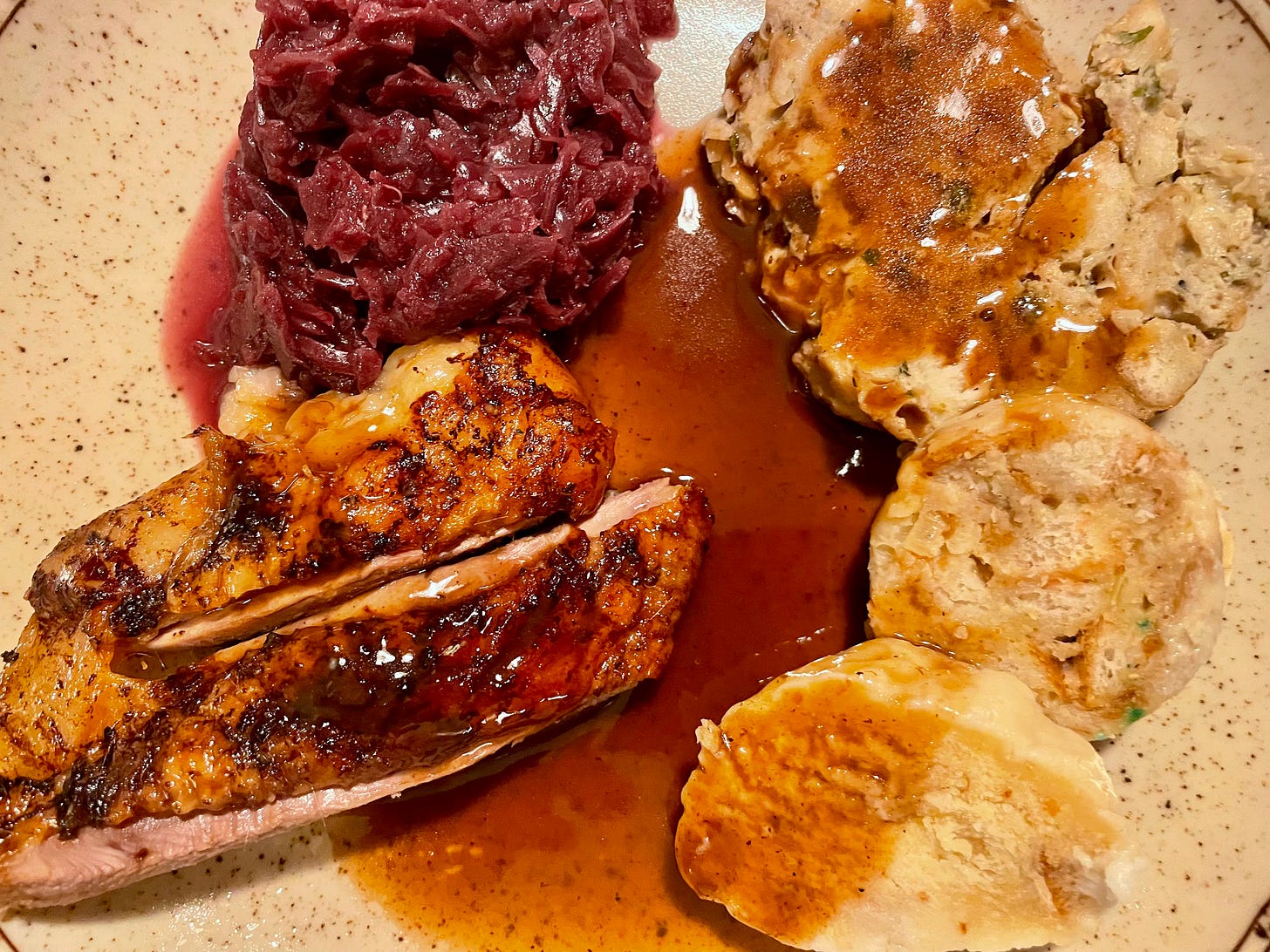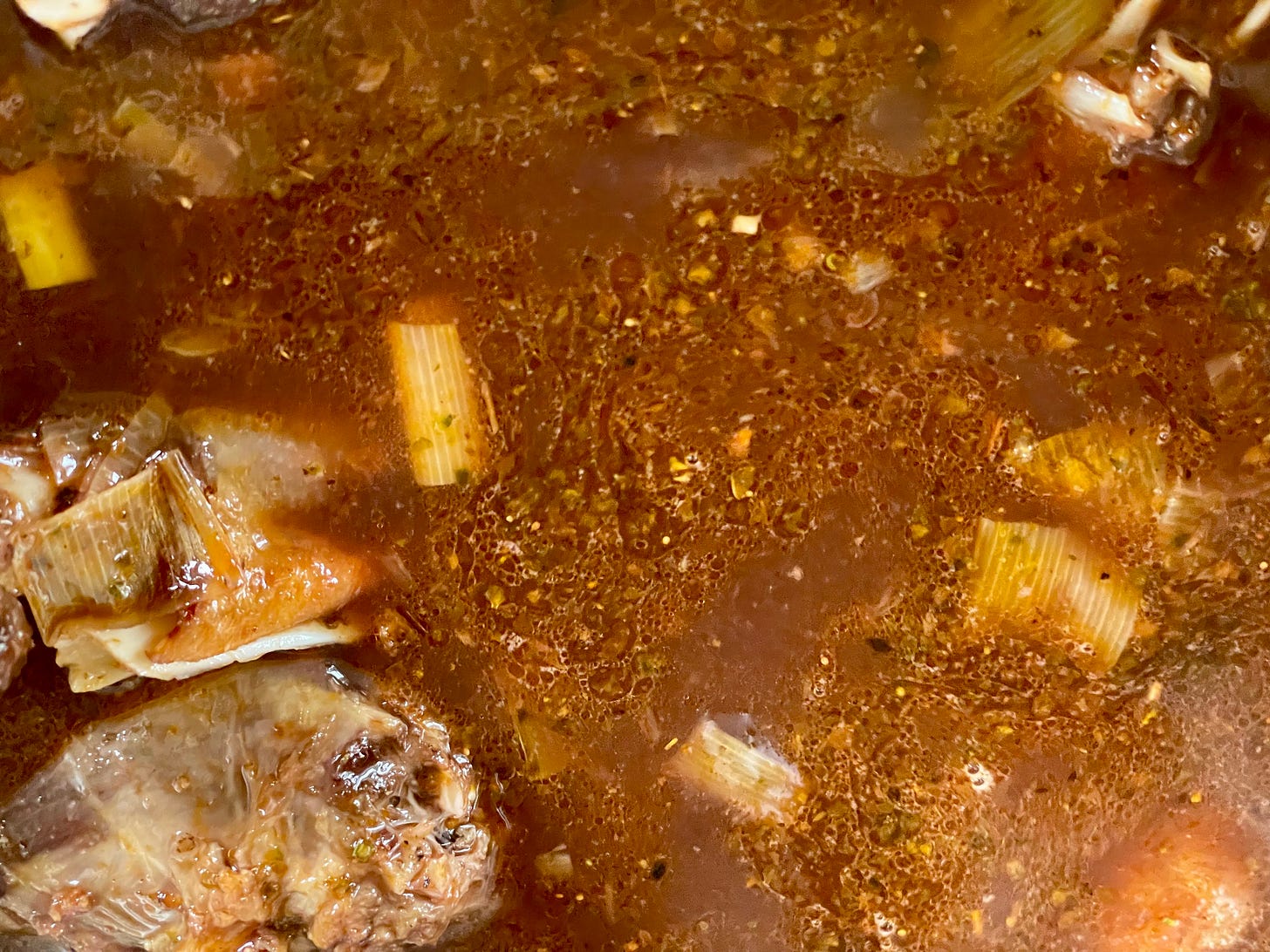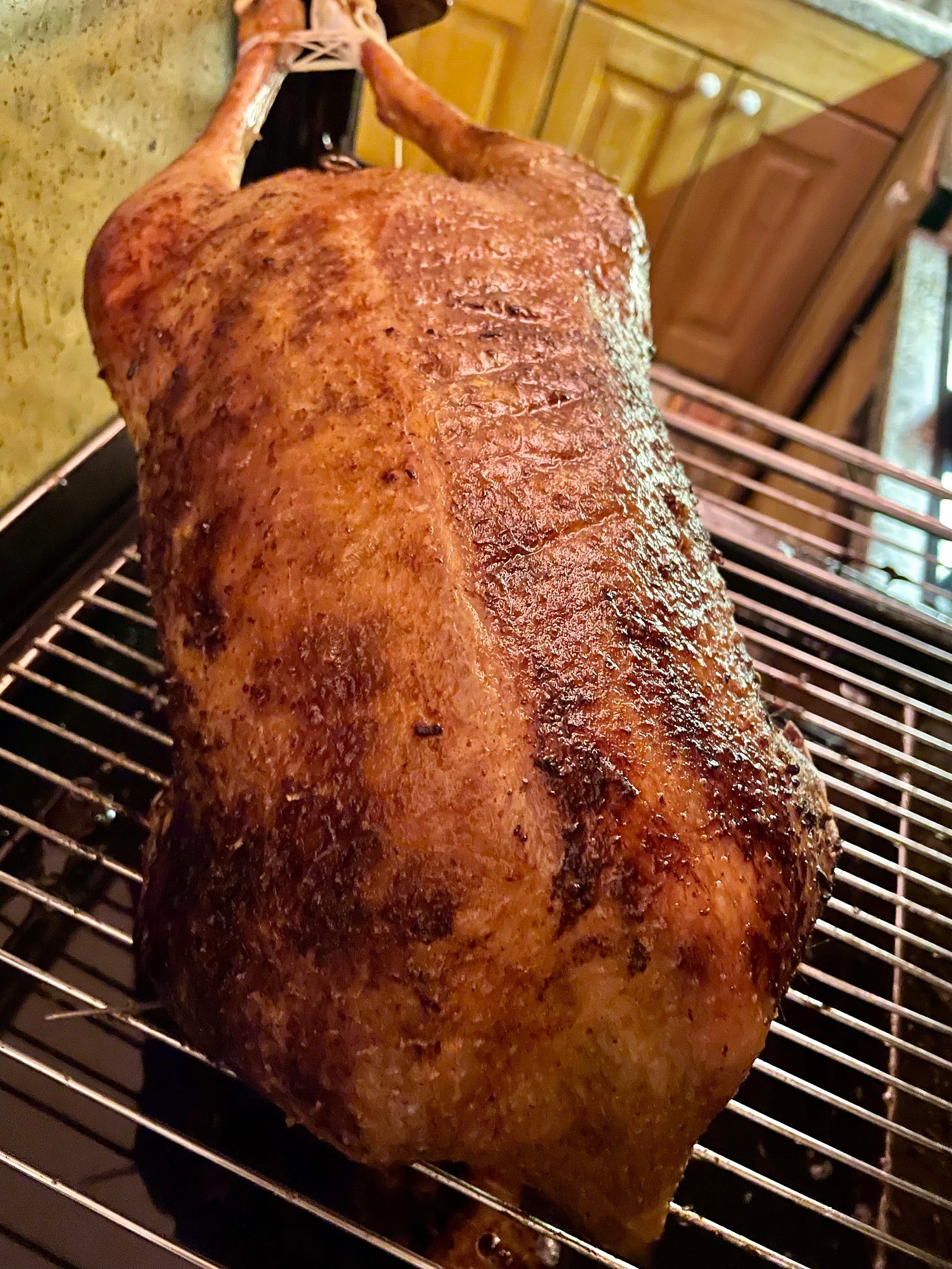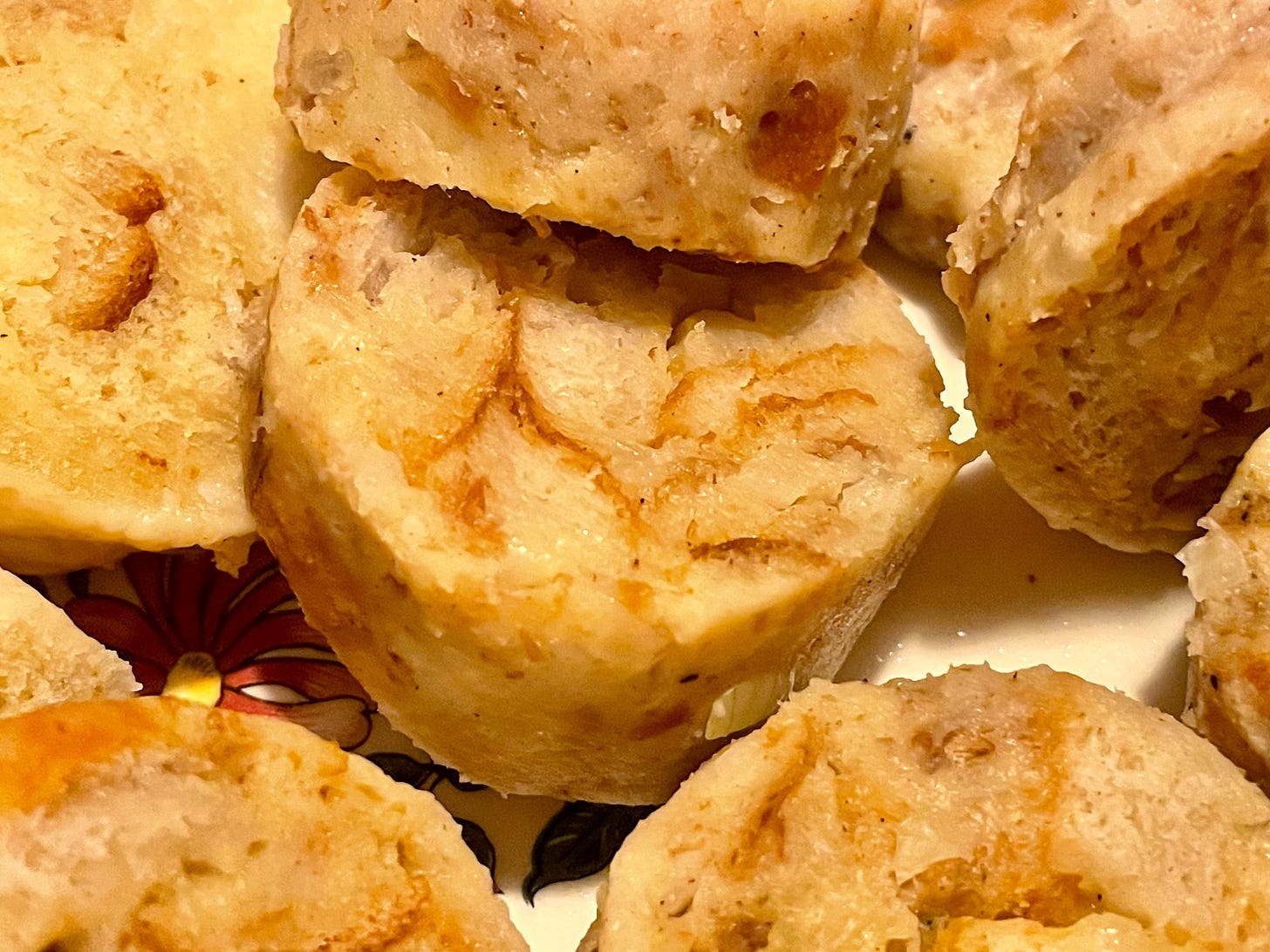How The German Martinsgans (Goose) Shaped My Holiday Feast
Tracing the rich history of a German tradition, its ties to St. Martin, and its place at my holiday table.

This November, I prepared a Martinsgans — a goose golden and fragrant, turning slowly in the low heat of my oven.
The long hours stretched into a kind of meditation, the kitchen filling with a scent that seemed older than memory itself: the sweetness of roasting trimmings, the tang of spiced red cabbage, and the dark promise of gravy simmering nearby.
As I basted the bird with butter, coaxing it toward perfection, I found myself reflecting not only on the meal but on the stories it carried — the layers of history, faith, and ritual that have accompanied it through centuries.
Light before the feast
Growing up in Northern Germany, the Martinsgans was as much a part of November as frost-covered mornings or the early, ink-black evenings of late autumn.
Yet my first memories of this tradition weren’t about the feast. They were about light.
On the evening of November 10th, we children carried lanterns through the streets. Handmade creations of paper and wire, each one carefully crafted to hold a flickering candle. The lanterns glowed softly, their colors dancing against the darkened houses as we sang songs of St. Martin.
Als Martin noch ein Knabe war, we chanted, our voices puffing small clouds into the cold air.
At every house, neighbors would open their doors to greet us with smiles and sweets.
The Martinsgans, however, came the next day — or the weekend closest to November 11th. That was when the real magic began.
Before the bird entered the oven, I roasted its trimmings — neck, wings, and any extra fat — until they darkened into a deep brown. These became the base of the gravy, a sauce both velvety and rich. The goose itself roasted low and slow, basted in butter rather than its own fat, which I reserved for other uses. The result was a bird that emerged golden, crackling, and fragrant.
Accompanying it were potato dumplings, eager to soak up every drop of gravy, and red cabbage, cooked slowly with cloves and vinegar until it turned tender and tangy.
But why a goose? Why this bird, and why November?
The Saint who inspired a feast
The answer begins with Martin of Tours, a man whose life and legacy stretch back to the 4th century. Born in 316 CE in Sabaria, in what is now Hungary (Catholic Online), Martin grew up in a Roman military family. His father, a tribune, expected him to follow the traditional path of a soldier.
Yet, Martin’s destiny lay elsewhere.
As a boy, Martin encountered Christianity — not through his family, who worshipped the Roman gods, but through his nurse, a servant who taught him about this new and radical faith. (Wikipedia: Martin of Tours) By the age of ten, Martin had declared himself a catechumen, committing to study and prepare for baptism.
This spiritual conviction stayed with him even as he entered the military, where the life of a soldier clashed with the tenets of his growing faith.
The defining moment came when Martin, serving in what is now Germany, encountered a freezing beggar. He cut his military cloak in half and wrapped the man in its warmth. That night, Martin dreamt of Christ wearing the cloak and heard the words, “What you have done for the least of my brothers, you have done for me.” (Britannica).
This act of compassion transformed him.
By his early twenties, Martin left the army, famously stating, “I am a soldier of Christ. I cannot fight.”
It was a declaration of non-violence and an embrace of humility, virtues that would define his life. (Heiligenlexikon).
Why the goose?
Martin’s association with the goose, however, comes from a moment of humor and humanity.
Years later, when Martin was chosen to become bishop of Tours, he fled to avoid the honor. Hiding in a goose pen, he was betrayed by the birds’ loud cackling, his sanctuary undone by their noise. He was found, reluctantly accepted the position, and became one of the most beloved figures in Western Christianity (Vivat!).
November 11th, Martin’s feast day, marked not just his burial but the end of the agricultural year in medieval Europe. Farmers culled livestock in preparation for winter, and geese fattened on the remnants of the harvest, were abundant.
The bird’s rich fat and flavorful meat made it an ideal centerpiece for feasts (Wikipedia: Martinstag). It symbolized the culmination of the harvest and the final indulgence before the fasting period of Advent (Chefsculinar).
This convergence of faith and farming gave rise to the Martinsgans tradition, which spread through the Frankish Empire and beyond.
Traditions across Europe
In Germany and Austria, the roasted goose became synonymous with St. Martin’s Day, accompanied by red cabbage and dumplings (Merkur.de).
In Hungary, where Martin was born, the feast often includes goose liver and sauerkraut. In the Czech Republic, the bird is paired with Böhmische Knödel (Bohemian dumplings) and braised red cabbage, a combination as rich as the land itself (Wiesbaden Lebt).
In Denmark and Sweden, Martin’s Day is celebrated with caramelized potatoes, lingonberries, and richly flavored goose, tying Nordic flavors into the tradition.
Yet not all regions embraced the Martinsgans. In France, Martin’s cult remained strong, but culinary traditions leaned toward foie gras and other uses of the goose, reflecting regional agricultural practices. (Vivat!).
In Switzerland, Belgium, and the Netherlands, Protestantism de-emphasized saintly veneration, leaving the Martinsgans to fade.
Still, in the regions where it thrives, the meal is as much about connection as it is about sustenance.
A connection to the Thanksgiving turkey
As I basted my goose for the final time, I thought of another bird, thousands of miles away: the Thanksgiving turkey.
Both geese and turkeys serve as the centerpieces of harvest celebrations, anchoring meals that bring people together. While geese are tied to medieval farming practices in Europe, turkeys became symbolic of abundance in the New World, where they were native and plentiful. (Wikipedia: Turkey (bird)).
The Thanksgiving turkey shares much with the Martinsgans — its size, its ceremonial preparation, its ability to gather family around a shared table. Both birds symbolize gratitude, abundance, and the rhythms of the seasons.
Yet their paths diverge. The turkey, introduced to Europe in the 16th century, gradually supplanted the goose as a Christmas bird in England and parts of Europe. In America, it became the centerpiece of Thanksgiving, a feast tied to the land and its harvest (Britannica: Thanksgiving).
The Virtues of St. Martin
When I carved my goose this year, I thought of Martin’s virtues — humility, non-violence, compassion — and how deeply they resonate. In our fast-moving, often disconnected world, his life offers a quiet challenge: to embrace humility when ego beckons, to choose peace when conflict tempts, and to see the humanity in those who are marginalized or in need (Heiligenlexikon).
What does humility look like in our lives today? Perhaps it’s in the small, uncelebrated acts of service: listening without interruption, sharing without expectation.
What about non-violence? Is it the courage to resist aggression — not only physical but also verbal or emotional?
And compassion — how often do we extend it, not just to others but to ourselves?
Martin’s life reminds us that these virtues are not grand gestures. They are choices, made daily, in the quiet spaces of our lives. The simple act of dividing his cloak was an extraordinary gesture precisely because it was so ordinary — a moment of connection, of seeing another’s need and responding (Catholic Online).
An invitation
As the meal drew to a close, my family lingered at the table, passing plates and sharing stories. The goose was not just sustenance; it was a gathering point, a ritual that tied us to each other and to the past. And as I savored the final bite, I felt the weight of Martin’s legacy — not as something distant or abstract, but as a call to action.
So, as you prepare your own meals this season, I invite you to pause. Think about Martin, the reluctant saint.
What small acts of kindness might you offer? What opportunities for humility, for peace, for compassion lie before you? The answers may surprise you.
But one thing is certain: they matter.
Just as they did then. Just as they always will.
Recipes
When I think of the aromas that filled my kitchen as the St. Martin’s goose slowly roasted in the oven, childhood memories flood back—of frosty November evenings, lantern parades, and the scent of spices and gravy wafting through the house. This recipe is a tribute to those traditions, but with a modern twist: a goose, succulent and filled with a mix of pretzel rolls and sausage meat, accompanied by aromatic spiced red cabbage and golden bread dumplings. It’s more than just a dish; it’s a feast that celebrates history, flavor, and community. Let’s fire up the oven and reimagine this timeless classic together.
All recipes serve 4.
Stuffed Goose with Pretzel and Sausage Filling
Adapted from Meine Klassiker by Alfons Schuhbeck, Gräfe & Unzer Verlag, 1st edition, 2010
Prep time: 1 hour | Cook time: 6 hours 30 minutes
Ingredients:
For the Goose:
1 goose (about 10 lbs / 4.5 kg)
8.8 oz (250 g) pretzel rolls, day-old
1 cup (250 ml) milk
2 eggs
Salt, black pepper
Freshly grated nutmeg
Allspice
1 tsp dried marjoram
1 tsp dried mugwort
1/2 onion
1 tbsp butter
8.8 oz (250 g) sausage meat
5 tbsp cream
1–2 tsp grated organic lemon zest
1 tbsp freshly chopped parsley
For the Sauce:
2 tsp powdered sugar
1/2 cup (125 ml) red wine
1/2 cup (125 ml) red port wine
1/2 pack soup vegetables, diced (1/2 leek, 1 carrot, 3.5 oz / 100 g celeriac, 1 parsley root)
1 red onion, diced
1 garlic clove, mashed with salt
1/2 inch (1 cm) ginger, grated
Goose fat or butter for sautéing
1 tbsp tomato paste
1 tsp dried marjoram
1 tsp dried borage
Pinch each of ground clove, cinnamon, star anise, and allspice
1 bay leaf
1 large jar (about 1–2 cups) goose stock
1–2 tsp cornstarch
2 sprigs parsley
1 strip organic orange peel
2 tbsp cold butter
Salt

Instructions:
Prepare the Goose:
Preheat the oven to 425°F (220°C, convection). Place a rack in the lower half of the oven and set a large roasting pan beneath it.
Trim the wings and neck, remove giblets, and rinse the goose inside and out. Pat dry. Generously season inside and out with salt and pepper.
Roast the Wings for the Sauce:
Chop the wings and neck into 1-inch (3 cm) pieces and place them in a shallow roasting pan. Roast for 30 minutes. Remove the fat and deglaze the roasting pan with about 2 cups of water, scraping up the browned bits. Save for the sauce. Reduce oven heat to 350°F (180°C, convection).
Prepare the Filling:
Cut the pretzel rolls into 0.5-inch (1 cm) cubes. Heat the milk and pour it over the cubes. Add eggs, salt, pepper, and nutmeg.
Finely dice the onion and sauté in butter until translucent. Let cool slightly and add to the pretzel mixture along with cream, lemon zest, marjoram, borage, and sausage meat. Mix well until a uniform yet textured filling forms. Adjust seasoning to taste. Stuff the goose with the mixture and seal the cavity with skewers or kitchen string.
Roast the Goose:
Brush the goose with salted melted butter and roast at 350°F (180°C) for 1 hour. Insert a meat thermometer—target internal temperature: 175°F (80°C).
After 1 hour, reduce the oven temperature to 210°F (100°C). Roast for 5–6 more hours, basting regularly with salted butter. Adjust the temperature as needed to ensure the goose cooks evenly and reaches the target temperature by your desired serving time. Larger geese may require more time.
Make the Sauce:
Caramelize powdered sugar until lightly golden. Add half the port wine and red wine, flambé to burn off the alcohol, and reduce by half. Repeat with the remaining wine.
Meanwhile, sauté the diced red onion and soup vegetables in goose fat or butter until softened. Add garlic and ginger, followed by the tomato paste, and cook briefly.
Combine the vegetable mixture with the wine reduction and deglazed pan drippings. Add goose stock, spices (marjoram, borage, clove, cinnamon, star anise, allspice, and bay leaf), and simmer gently for 1–1.5 hours. Strain through a sieve.
Shortly before serving, bring the sauce to a boil. Add parsley stems and orange peel and let steep for 5 minutes. Dissolve cornstarch in orange juice or port wine, stir into the sauce, and cook for 2 minutes. Adjust seasoning with salt and citrus honey. Finish with cold butter for a glossy texture.
Serve:
Carve the goose into legs and breast fillets. Slice the stuffing and arrange on plates with the goose and sauce.

Spiced Red Cabbage
Ingredients:
1 large jar red cabbage (about 16 oz / 480 g)
1 tbsp powdered sugar
1/2 cup (100 ml) port wine
Juice of 1 orange
1 apple, peeled and diced
1 small red onion, sautéed in goose fat or butter
1 bay leaf
Spice sachet: 5 allspice berries, 1/2 tsp black peppercorns, 1 piece cinnamon stick, 3 star anise points, 1/2 inch fresh ginger, 1 strip organic orange peel
1–2 tbsp cold butter
Salt, sugar
Instructions:
Sauté the diced red onion in goose fat or butter until soft. Set aside. Prepare the spice sachet with a piece of cheesecloth or tea bag. Dice the apple and juice the orange.
Caramelize powdered sugar in a pot until golden. Add port wine and flambé. Reduce to one-third.
Add the red cabbage from the jar, apple, orange juice, spice sachet, and bay leaf to the pot. Simmer uncovered on low heat for about 1 hour, stirring occasionally.
Remove the spice sachet and season to taste with salt and sugar. Stir in cold butter until the sauce thickens slightly and the cabbage glistens.

Serviettenknödel (Napkin Bread Dumplings)
Ingredients:
4.4 oz (125 g) day-old rolls or bread (about 2–3 small rolls)
1/2 cup (125 ml) milk
1 medium egg (size M)
0.9 oz (25 g) onion, diced
0.9 oz (25 g) butter
0.26 oz (7.5 g) parsley, chopped
1 pinch freshly grated nutmeg
1/2 tsp salt
1/8 tsp black pepper
Instructions:
Heat milk until hot (not boiling) and season with salt, pepper, and nutmeg. Pour over diced bread and let soak for 10–20 minutes.
Sauté onion in butter until translucent. Add to bread mixture with chopped parsley.
Add the egg and mix until a cohesive dough forms.
Shape into a roll using heatproof plastic wrap or a damp kitchen towel. Twist ends tightly and secure with string.
Gently simmer in salted water for 20–30 minutes.
Slice into rounds and serve.
Enjoy!





This is wonderful culinary history! Thank you for this, Jay.